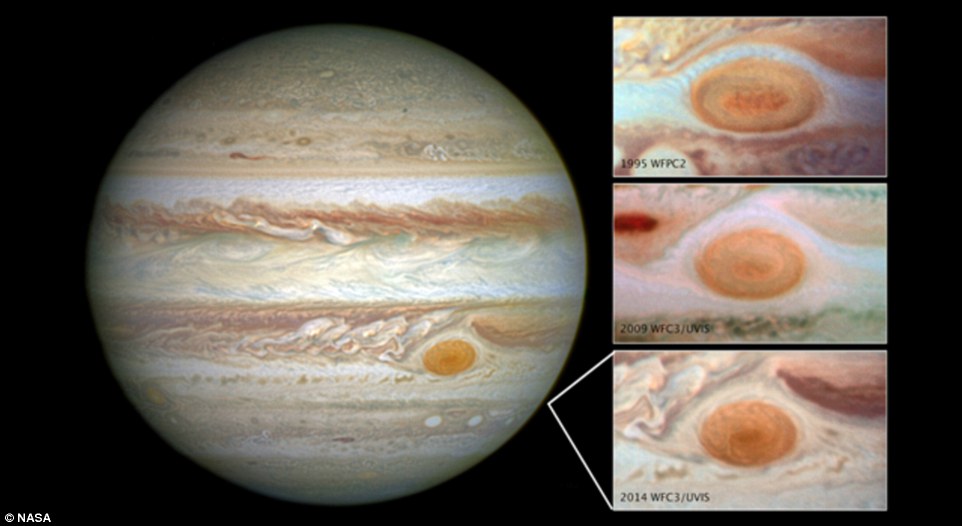One of the most spectacular storms in the solar system is changing colour.
Once big enough to swallow three Earths, Jupiter’s ‘Great Red Spot’ is shrivelling at a rate of 140 miles (230km) per year, driving its cloud tops upwards, according to a new Nasa study.
Chemicals that give the oval-shaped storm its reddish hue are being lifted to higher altitudes, which may explain why the spot is gradually a more intense orange, researchers said.
Scientists believe the storm is likely to disappear altogether within 20 years.
Scientists suggest the changes are the result of the storm’s shifting winds, which reach speeds of 425 miles per hour (680kph) as they push Jupiter’s crimson clouds counterclockwise around the planet’s southern hemisphere.
‘Storms are dynamic, and that’s what we see with the Great Red Spot. It’s constantly changing in size and shape, and its winds shift, as well,’ said Dr Amy Simon, an expert in planetary atmospheres at Nasa’s Goddard Space Flight Center in Greenbelt, Maryland, and lead author of the new paper.
Observations of Jupiter date back centuries, but the first confirmed sighting of the Great Red Spot was in 1831.
Keen observers have long been able to measure the size and drift of the Great Red Spot by fitting their telescopes with an eyepiece scored with crosshairs.
A continuous record of at least one observation of this kind per year dates back to 1878.
The Nasa team combined these observations with data from Nasa spacecraft that have visited Jupiter, from Voyager in 1979, to Galileo in 1995, up to the ongoing Juno mission, which reached the planet’s orbit in July 2016.


They analysed the spot’s size, shape, colour and drift rate alongside the storm’s internal wind speeds, when that information was available from spacecraft.
The study shows the storm has been shrinking since 1878 and is now big enough to accommodate just over one Earth. In the 1800’s it was wide enough for four Earths to fit side by side.
But what the huge spot is losing in girth, it is gaining in height.
By measuring how the storm reflected ultraviolet light over several decades, the team concluded that its cloud tops are getting higher.

Because the storm has been contracting, the researchers expected to find the already-powerful internal winds becoming even stronger, like an ice skater who spins faster as she pulls in her arms.
But instead of accelerating, the storm appears to be forced to stretch up.
‘It’s almost like clay being shaped on a potter’s wheel,’ Nasa said in a statement.
‘As the wheel spins, an artist can transform a short, round lump into a tall, thin vase by pushing inward with his hands. The smaller he makes the base, the taller the vessel will grow.’


The Great Red Spot’s colour has been deepening, too, becoming intensely orange since 2014.
Researchers aren’t sure why this is happening, but it’s possible the chemicals that give the storm its reddish hue are being carried higher into the atmosphere as the spot stretches up.
At higher altitudes, the chemicals are subjected to more UV radiation and would take on a deeper colour.
Researchers said they don’t know whether the spot will shrink a bit more and then stabilise, or break apart completely.



‘If the trends we see in the Great Red Spot continue, the next five to 10 years could be very interesting from a dynamical point of view,’ said Nasa Goddard centre scientist and study co-author Dr Rick Cosentino.
‘We could see rapid changes in the storm’s physical appearance and behaviour, and maybe the red spot will end up being not so great after all.’
Jupiter’s Great Red Spot is a giant oval of crimson-colored clouds in Jupiter’s southern hemisphere that race counterclockwise around the oval’s perimeter with wind speeds greater than any storm on Earth.
Dr Glenn Orton, a Juno mission team member and a planetary scientist at NASA JPL, told Business Insider last month that the Great Red Spot is like a ‘spinning wheel that keeps on spinning because it’s caught between two conveyor belts that are moving in opposite directions.
‘The GRS is stable and long-lived, because it’s ‘wedged’ between two jet streams that are moving in opposite directions.’
But Dr Orton warned its days are numbered. ‘In truth, the GRS has been shrinking for a long time,’ he said.
‘The GRS will in a decade or two become the GRC (Great Red Circle),’ Orton said. ‘Maybe sometime after that the GRM’ – the Great Red Memory.













